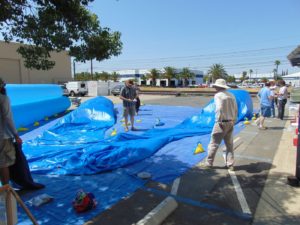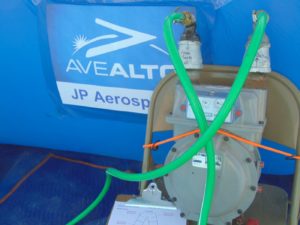

Ascender 36 flight at “Area 42” ( 9/11/2016 ) reached 13,512 feet
The first flight of Ascender 36 was a shake down flight and the first flight at the Area 42 test site. Due to losses in helium and our slow filling method helium was lost and the wind picked up. We picked up erratic winds instead of the calm day forecast. The most important test point was to reach the minimum altitude of 7,000 feet. If the flight continued on we would let it up to 10,000 feet. Our goal the climb rate was 400 feet per minute. Im always so happy to volunteer for JP’s programs.
However, we reached 13,512 feet and 582 feet per minute and 11 miles down range. Better than expected.
Check out and Prep
- Here’s the check out of the vehicle several weeks before flight.
- Two main trusses made out of Carbon fiber rods, surprisingly light even for carbon.
- Aerial view with the wind blocking tubes. Filled with air as helium would be expensive and cause lift off.
Check out and preparations are made weeks before flight. Fits, pieces, assemblies, procedures and electrical are all tested. As you can see it takes quite a bit just to unfold the delicate balloon in our parking lot. The filling is done via a large fan for two reasons. First, helium is enormously expensive, second its a suffocation hazard and several of us end up inside for one reason or another solving problems.
Transport and Arrival:
- We leave Sacramento California and get a few hours of sleep in Nevada, then its up at 4:30am for the flight brief. Then the convoy sets out.
- Arriving at the secret test site. Far in the Nevada desert, no moon.
- Parking more than a dozen cars and unpacking, it was cold !
Transports always begin first thing Saturday mornings. We meet as a group, form up our vehicles and get our assignments. We leave from Sacramento California through the Sierra Mountains and Donner Pass to Nevada. Even from there its still quite awhile to our test site. We arrive at the same motel at night, then get a few hours of sleep till about 4:30 am. Then its up for the preflight briefing with the final assignments last minute changes and weather updates. Quickly we form up and then its on to the test site for the day.
Setup and Staging
- Staging as much as possible before the sun rises, we only have several hours of an FAA approved flight window. So every hour counts.
- Unloading the wind barriers sand bags and tarps.
- Wind ramps . filled by fans.
Its an enormous amount of material to be moved out for the flight, several hours even with so many people. The Tarps, helium cylinders and wind ramps are the high priority as mornings are calm. The “Wind Ramps” as we call them, are meant to block the first few feet of wind above the ground, the seem to help but they’re not perfect.
- The inside of one envelope
- We brought about $5,000 in helium for this test. We own the tanks and buy the helium.
- Making sure the avionics survived the road trip.
The inside of one leg can be seen on the left. the curtain keeps the inner cells in place. We bring more helium just in case, and for this flight it was a good thing too we lost some buoyancy. We have our electronics person Andrew, immediately start checking out the avionics. Its always tense when it all worked at home, but wont work just before the flight for some mysterious reason.
Avionics:
- Onboard electronics with lithum battery. GPS with radio transmitting capability.
- The center carbon fiber tubes also support the electronics box.
- Inside the top there are some simple circuits to bring down the balloon as a safety feature.
- Angles and direction finding for line of site communications.
- Setting up directional antennas.
- Corner reflector for radar visibility.
Setting up the avionics takes quite awhile including several cameras, there is also all of the support electronics on the ground that needs to be setup.
Filling:
- Filling order.
- Gas flow metering per cell.
- Myself on the tanks.
Filling begins as soon as possible, that means when the delicate cells can be put in. We have strict assembly and filling instructions and numbers. There is a left group and a right group, both should be inflating as equally as possible while still inflating according to their own numbers.
Flight:
Finally we got it buoyant and let it go. It rose fast, and pitched nose up almost 90 degrees. After about 200 feet up and 400 feet away, this airship was going for a successful trip.
It really started to move out to the East pretty fast and its vertical speed was much faster than predicted (582 fpm). It righted itself from the previous attitude.
It went a total of 11 miles down range, before we brought it down. Over all it was pretty successful despite the failure of the on-board cameras.
Recovery:
- The first sight of the cash site as we pulled up.r
- M.S. Charles Galindo Jr., Planetary Scientist from NASA and myself holding a broken truss.
- It looks bad, but it was all easily fixed, some sewing, carbon and tape would be enough.
More Pictures and Video:
- Several of the safety vents scene here.
- A burn through test of the thin film by hot nichrome wire.
- The inner gas cells, very thin polyethylene..
- Our backer on the left and Jonh Powell on the right.
- Myself in front of our sponsors logo
- It touched down nose first and tail high while dragging itself about 200 feet, leaving marks on the desert floor. Of course the nose cameras were found in a shrub, ripped off when they were rammed into the groud.
Group picture for acender 36 flight:
Myself at Test Site “Area 42”.

Nevada, Area 42
,










































